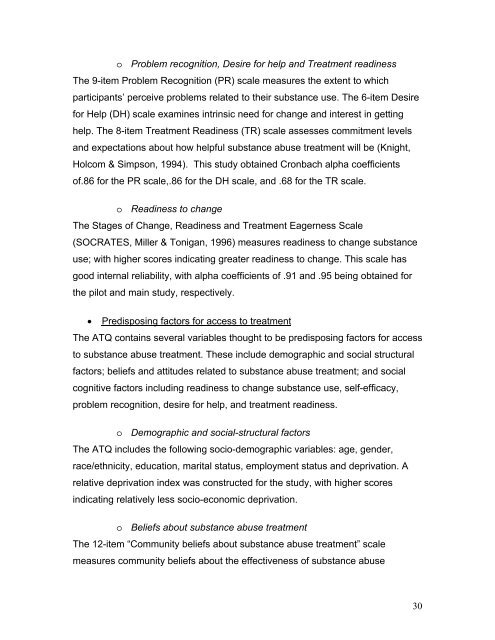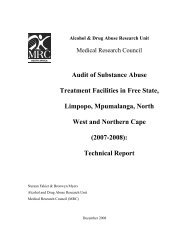Access to substance abuse treatment in the Cape Town metropole ...
Access to substance abuse treatment in the Cape Town metropole ...
Access to substance abuse treatment in the Cape Town metropole ...
Create successful ePaper yourself
Turn your PDF publications into a flip-book with our unique Google optimized e-Paper software.
o Problem recognition, Desire for help and Treatment read<strong>in</strong>essThe 9-item Problem Recognition (PR) scale measures <strong>the</strong> extent <strong>to</strong> whichparticipants’ perceive problems related <strong>to</strong> <strong>the</strong>ir <strong>substance</strong> use. The 6-item Desirefor Help (DH) scale exam<strong>in</strong>es <strong>in</strong>tr<strong>in</strong>sic need for change and <strong>in</strong>terest <strong>in</strong> gett<strong>in</strong>ghelp. The 8-item Treatment Read<strong>in</strong>ess (TR) scale assesses commitment levelsand expectations about how helpful <strong>substance</strong> <strong>abuse</strong> <strong>treatment</strong> will be (Knight,Holcom & Simpson, 1994). This study obta<strong>in</strong>ed Cronbach alpha coefficientsof.86 for <strong>the</strong> PR scale,.86 for <strong>the</strong> DH scale, and .68 for <strong>the</strong> TR scale.o Read<strong>in</strong>ess <strong>to</strong> changeThe Stages of Change, Read<strong>in</strong>ess and Treatment Eagerness Scale(SOCRATES, Miller & Tonigan, 1996) measures read<strong>in</strong>ess <strong>to</strong> change <strong>substance</strong>use; with higher scores <strong>in</strong>dicat<strong>in</strong>g greater read<strong>in</strong>ess <strong>to</strong> change. This scale hasgood <strong>in</strong>ternal reliability, with alpha coefficients of .91 and .95 be<strong>in</strong>g obta<strong>in</strong>ed for<strong>the</strong> pilot and ma<strong>in</strong> study, respectively.• Predispos<strong>in</strong>g fac<strong>to</strong>rs for access <strong>to</strong> <strong>treatment</strong>The ATQ conta<strong>in</strong>s several variables thought <strong>to</strong> be predispos<strong>in</strong>g fac<strong>to</strong>rs for access<strong>to</strong> <strong>substance</strong> <strong>abuse</strong> <strong>treatment</strong>. These <strong>in</strong>clude demographic and social structuralfac<strong>to</strong>rs; beliefs and attitudes related <strong>to</strong> <strong>substance</strong> <strong>abuse</strong> <strong>treatment</strong>; and socialcognitive fac<strong>to</strong>rs <strong>in</strong>clud<strong>in</strong>g read<strong>in</strong>ess <strong>to</strong> change <strong>substance</strong> use, self-efficacy,problem recognition, desire for help, and <strong>treatment</strong> read<strong>in</strong>ess.o Demographic and social-structural fac<strong>to</strong>rsThe ATQ <strong>in</strong>cludes <strong>the</strong> follow<strong>in</strong>g socio-demographic variables: age, gender,race/ethnicity, education, marital status, employment status and deprivation. Arelative deprivation <strong>in</strong>dex was constructed for <strong>the</strong> study, with higher scores<strong>in</strong>dicat<strong>in</strong>g relatively less socio-economic deprivation.o Beliefs about <strong>substance</strong> <strong>abuse</strong> <strong>treatment</strong>The 12-item “Community beliefs about <strong>substance</strong> <strong>abuse</strong> <strong>treatment</strong>” scalemeasures community beliefs about <strong>the</strong> effectiveness of <strong>substance</strong> <strong>abuse</strong>30
















